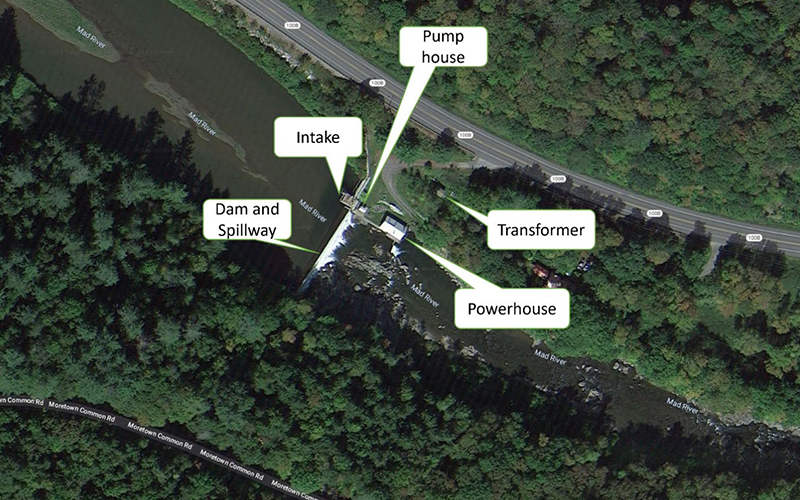Federal regulators and the operators of the Moretown No. 8 dam on the Mad River, are recommending a variety of changes, including creating and instituting plans that will better protect the environment and the habitat it provides as well as improve and preserve recreational access.
The Moretown No. 8 dam, originally built in 1910, has seen many an ice jam, rainstorm, and flood in the last 113 years. Currently owned by Moretown Hydroelectric LLC, the dam has not been producing electricity throughout its life; a 30-year hiatus during the 20th century ended in 1989 when the dam resumed production. It has remained in operation ever since.
Moretown No. 8 is under review for relicensing by the Federal Energy Regulatory Commission. A couple of changes to the dam are included in the proposal: some modifications to equipment at the site to increase efficiency, and an expansion of the site by about a third of an acre. An Environmental Impact Report, created by FERC staff, offers insight into the dam’s functioning and its impact on the surrounding landscape. Among the report’s findings are several environmental recommendations, some from the dam’s operators and some added by the Commission. They include the dam’s effects on the surrounding environment, as well as recreational and cultural considerations.
Many species live in and around the Mad River near the dam, including brook, rainbow, and brown trout; Eastern pearlshell mussels live in nearby stretches of the Winooski River. Various mammals and birds also live nearby, including seven birds that breed in the area of the dam project. Among these are Canada warblers, bobolinks, and wood thrushes. The dam is also in the vicinity of various recreation sites, including an access and portage used by kayakers and other boaters, as well as Kenneth Ward Park, which is located less than a mile upstream.
Per FERC’s report, Moretown Hydroelectric suggested several measures to protect the environment in the dam’s surroundings. First, the company suggested the run-of-the-river operation of the dam continue. This means that inflow to the dam is equal to outflow from it. Moretown Hydro furthermore proposed the development of a plan for flow management and monitoring, which would allow the company to keep track of the dam’s operation, flow, and drawdown rates. A water level management plan for drawdown periods would help to curtail any consequences for the surrounding ecosystem, and summer drawdowns would be limited. The company also suggested the creation of a plan for a freshwater mussel survey. Finally, a plan for managing recreation around the area of the dam, including boating access management and signage, was included.
FERC staff included Moretown Hydro’s proposals, plus a couple of further suggestions, in their own proposal. These included enacting procedures for reporting any deviation from dam operation requirements to both FERC and Vermont’s Department of Environmental Conservation; a plan to perform a survey for freshwater mussels before maintenance drawdown events; a discussion with DEC staff in advance of planned dam drawdowns; and a need to approach FERC should the downstream boat entry location become inaccessible. Also listed are a plan to protect trees potentially needed by endangered northern long-eared bats (the recommendation would also protect endangered tricolored bats), and to work with the Vermont State Historic Preservation Office and FERC to identify whether cultural resources (i.e. archaeological materials or sites) require protection at the dam site. A previous survey found no such materials in need of protection at the site.
The report noted that while Kenneth Ward Park is under a mile from the dam, it is operated by the Vermont Department of Fish and Wildlife and does not fall within the property owned by Moretown Hydro. Drawdowns at the dam could, due to its proximity, affect water levels at the Ward swim hole, so such drawdowns are limited through the summer. Another potential recreational impact of the dam is the boating put-ins and portage associated with the site. The report also suggested a provision in the new license to notify FERC if a nearby private property access becomes inaccessible, so that FERC could make sure that boating access below the dam remained available. Moretown Hydro has also mown the boat access path and added signs to indicate where boaters could reach the water. The report suggests that a recreation plan with scheduled maintenance included would also help to keep access open for boaters.
State and federal fish and wildlife officials also had the opportunity to file recommendations regarding the protection of fish and other wildlife impacted by the dam, but chose not to file any such documents.













